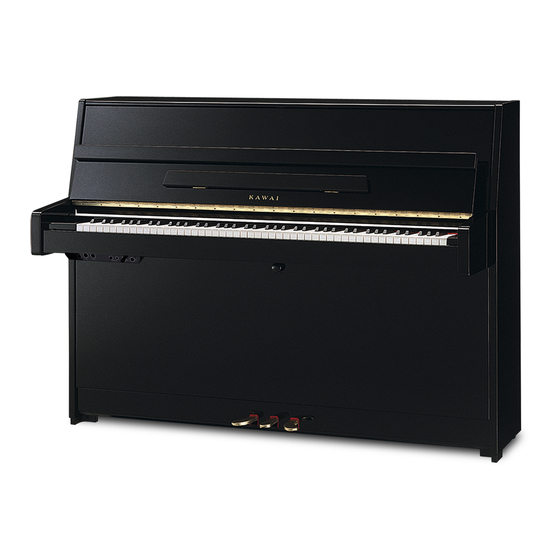
Summarization of Contents
Introduction to Kawai ATX3
Part Names and Functions
Details of the instrument's physical parts and their functions, including ports and controls.
Setting Up the Piano
Instructions for connecting the power, turning on the instrument, and activating AnyTime Mode.
Touchscreen Operations
Explains how to interact with the touchscreen display using tap, swipe, and long press gestures.
User Interface Overview
Describes the four main screens (Pianist, Sound, Music, Favorite) and their components.
Playing the Piano
Pianist Mode Operations
Using the SK-EX Rendering sound engine, adjusting character and resonance.
Sound Mode Operations
Using the secondary sound engine, including Single, Dual, Split, and 4Hands modes.
Sound Effects and Practice Tools
Adjusting Reverb, Effects, Metronome, and Drum Patterns for sound shaping and practice.
Recorder Functions
Recorder Function Overview
Explains recording capabilities, formats, and memory differences between Pianist and Sound modes.
Recording Songs and Audio
How to record songs in Pianist/Sound modes and as audio files to USB memory.
Music Screen Features
Music Screen Access
Access to Demo Songs, Piano Music, Lesson Songs, Concert Magic, and Recorder Playback.
Practice and Performance Tools
Using Lesson Songs for piano practice and Concert Magic for beginner performance.
Favorite Screen Functionality
Favorite Memory Management
Storing, selecting, editing, and renaming favorite instrument setups for quick recall.
Instrument Settings
Pianist and Sound Mode Settings
Configuration options for Ambience, Virtual Technician, Sound Settings, and System Settings.
Virtual Technician Customization
In-depth adjustment of piano characteristics like Touch Curve, Voicing, and Resonance.
Sound Settings Details
Adjusting Tuning, Tone Control, Line In Level, SHS Mode, and Phones settings.
System and Connectivity Settings
Managing Bluetooth, MIDI, USB functions, and display options.
Bluetooth and USB Operations
Setting up and using Bluetooth MIDI/Audio, and managing USB memory files.
MIDI Functions and Setup
Understanding MIDI terminals, channels, and functions for instrument connection.
Appendix and Support
Connectivity and Device Information
Overview of jacks, USB MIDI, and connecting to external devices.
Troubleshooting Common Issues
Solutions for common power, sound, headphone, USB, and MIDI connection problems.
Reference Lists
Lists of Demo Songs, Sound List, and Program Change Numbers for quick reference.









Need help?
Do you have a question about the K-200 ATX3 and is the answer not in the manual?
Questions and answers